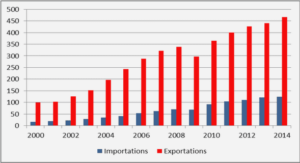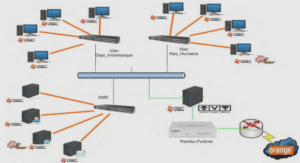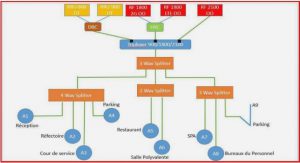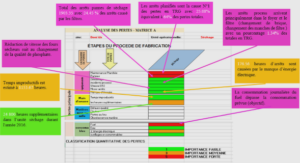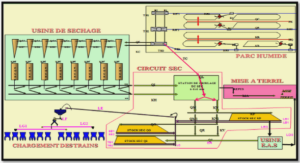EFFECTS OF SINGLE DOMINANT REFLECTION ON SIGNAL MODULATION
Theoretical analysis of reflection from a flat wall
Propagation geometry
The types of areas considered in this study contain buildings on relatively flat terrain. When these reflectors are not present, the usual models (line-of-sight and ground reflections) prevail. When these isolated buildings are present however, the nature of the channel is significantly modified and should be taken into account at a system level. It is the typical very bad channel . In the suburban case, most buildings are not as large as those in a downtown type of environment and consist of individual family houses, apartment buildings and moderately sized office buildings. For the rural case, the buildings consist of single houses and small clusters of farm buildings. A base station with an antenna on a 20 m mast is located on level ground and is transmitting to a vehicle having an antenna mounted at a height of 2 m. A building is located near the vehicle. The building, vehicle and base station are all in line to simplify the calculations. The antennas are vertically polarized. The distance between the base station and the mobile is up to 10 km. The building is modelled as a plane reflecting wall of height H and width W. The ground is also considered as a plane reflector. The communication link is a continuous full duplex link and the link frequencies are around 300
MHz. The data rates are considered to be of the order of 1 Mb/s.
Simplified geometric optics model, no ground reflection
In a first analysis, we consider the case of no ground reflection, with the base station and vehicle antennas aligned with the center of the reflecting wall. Let the incident electric field at the wall be Ei and the scattered field be Es. This field will be almost parallel to the wall since the base station is considered to be far away. If the wall is considered to be infinite, the reflected field will be Es = ρw Ei close to the wall. In practice, if the reflecting surface and the principal radii of curvature at the reflecting point are much larger than the wavelength, geometric optics may be used to calculate the reflected field close to the surface using the Fresnel reflection coefficient and the principal radii of curvature .
Physical optics model, no ground reflection
However, it is known that the near field of an aperture antenna, although roughly constant, varies significantly with location in a very complex way . Therefore, a more precise scattering model using the physical optics approximation is required here. This approach assumes that the reflected field near the reflecting surface is given by ρw·Ei. However, the field at any other point is obtained by evaluating an integral over the reflecting surface. In Beckmann and Spizzichino, this integral is the Helmholtz Integral. An equivalent approach replaces the reflecting surface by an equivalent current sheet whose surface current density is derived from the reflected fields. The latter approach is used here. This method does not take into account any edge effects. The reflected fields are assumed to be discontinuous at the edges of the reflecting surface, which is not realistic. However, Balanis states that the method is fairly accurate for calculating scattered fields in directions not far away from the direction of specular reflection.
Physical optics model with ground reflections
The methods of Part c) are adapted to this configuration. The reflection of the base station signal from the ground plane is modelled by assuming a second signal coming from an image below the ground plane, the field being multiplied by a reflection coefficient ρg for a vertically polarized wave. The desired electric field at the mobile is calculated using the geometric optics theory. The incident electric field at each point of the wall is also calculated using geometric optics. The incident fields at the wall are assumed to be parallel to the wall, which is a valid approximation (for the wall sizes considered here) if the base station is at least 500 m from the wall. Equivalent current elements are calculated for each wall element using Equation , where the incident field is the sum of a direct field and a ground reflected field. The reflection coefficient for the wall is that for broadside incidence.
The fields radiated by the wall current elements consist of a direct field to the mobile and a ground reflected field, which is assumed to come from an image of the current element below the ground plane and is multiplied by a ground reflection coefficient for a vertically polarized wave. The vertical component of the field at the mobile location is calculated.
Reflection from other surfaces
The analysis given above has focussed on the case where the reflector is a flat building wall.
Many structures have more complex shapes, as do natural reflectors such as hills or trees. This section briefly considers more general structures. The scattering behaviour of a general structure will obviously depend on its shape and each structure will behave somewhat differently.
Consider first a surface made up of a number of plane facets. In this case, to a first approximation, each facet will produce a specular reflection like the flat walls analyzed above. Each specular reflection will have a near zone and a far zone governed by its area and the wavelength. There will also be diffraction from edges but their effect is smaller than that of the specular reflections.
Measurement methods
The experiments consisted of running a full duplex communications link between a base station and a moving vehicle. The base station had an omnidirectional (in azimuth) vertically polarized antenna on top of a 20 m mast. The vehicle was a pickup truck with a vertical antenna mounted in the back. The base of the antenna was at a height of roughly 2 m above the ground and the length of the antenna was about 2 m. The base station and vehicle antennas were the same type, vertical dipole arrays having a nominal gain of 4 dBi. The communication links were run at frequencies in the range of 300 MHz to 400 MHz at bit rates of 1 Mb/s to 3 Mb/s using simple modulation formats. During the experiments, received error rates, received signal levels and received spectra were
monitored.
Also, the mobile contained a video camera and the base station had a monitor, allowing an assessment of the structures near the mobile when the link performance was poor. In addition, in one case, a pulse transmitter was used to directly study the reflections.
Results
The experimental results are divided into four sections. The first gives typical distributions of error rates. The second shows examples of measured spectra. The third illustrates measurements of received levels. The fourth shows the results of the pulse transmitter tests.
These results are shown in the following sub-sections.
Error rate distributions
It was typically found that the link performance would be either good with few errors or very poor with high error rates and frequent loss of link synchronization. Link error rates were monitored continuously during a test run and sampled every 2 seconds. The results are summarized as a distribution of the sample values i.e. the percentage of samples with various error rates. These results were obtained with a link using binary FM modulation, a form of continuous phase FSK extensively used in military systems, at a transmitted bit rate of 1 Mb/s, although similar results were obtained with other simple modulation methods.
Spectrum measurements in bad areas
During the test runs, received spectra were monitored continuously using a spectrum analyzer. Spectra were recorded throughout the run to capture typical responses, especially when the mobile entered a “bad” area. Sampling was done manually so that the number of recordings is not large but the recorded spectra are very representative. Most measurements were made at the base station but the spectra at the mobile were found to be similar. Measurements were made both at RF frequency and at the receiver IF frequency. In the first case, the spectrum analyzer was used as a receiver directly and was preceded by a low noise amplifier. In the second case, the radio receiver was used and measurements were made using a spectrum analyzer at the IF frequency of 140 MHz. Figures 3.6 to 3.10 show typical spectra.
Level measurements
Some test runs were made to measure received signal level using a spectrum analyzer set to zero span mode (i.e. sweeping in time at a fixed frequency). The resolution bandwidth of the analyzer was set large enough to capture most of the received signal energy. The video bandwidth was selected to smooth the signal, consistent with the sweep rate. Generally, it was set equal to or slightly less than the resolution bandwidth.
Measurements were made both at RF frequency and at the receiver IF frequency. In the first case, the spectrum analyzer was used as a receiver directly and was preceded by a low noise amplifier. In the second case, the radio receiver, with the RF AGC disabled, was used and measurements were made using a spectrum analyzer at the IF frequency of 140 MHz. The signal on the link was a 1 Mb/s QPSK modulation.
|
Table des matières
INTRODUCTION
CHAPTER 1 BACKGROUND AND LITERATURE SURVEY
CHAPTER 2 THEORY
2.1 General
2.2 Theoretical analysis of reflection from a flat wall
2.3 Reflection from other surfaces
2.4 Summary and evaluation of analysis results
CHAPTER 3 EXPERIMENTAL RESULTS
3.1 General
3.2 Experimental results
3.2.1 Measurement methods
3.2.2 Results
3.2.3 Summary and analysis of experimental results
CHAPTER 4 APPLICATIONS
4.1 Propagation models for practical channels
4.2 Estimation of link availability
4.3 Example of outage area prediction
CHAPTER 5 EFFECTS OF SINGLE DOMINANT REFLECTION ON SIGNAL MODULATION
5.1 General
5.2 Mathematical models of modulated signals
5.3 Delay and doppler effects
5.4 Effect of reflections on modulated signals
5.5 Effects of single dominant reflection on signal spectrum
5.6 Effects of single dominant reflection on receiver synchronization
5.6.1 Aspects of synchronization
5.6.2 Steady state timing and carrier recovery phase errors due to single reflection
5.7 Direct sequence spread spectrum systems
5.8 OFDM systems
5.9 Performance of other receivers
CONCLUSIONS
![]() Télécharger le rapport complet
Télécharger le rapport complet

